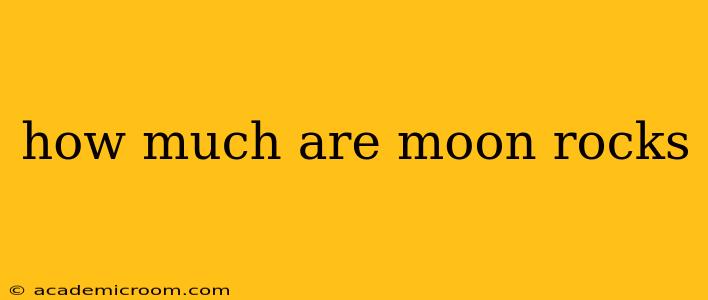How Much Are Moon Rocks? A Look at Lunar Sample Value and Availability
The question "How much are moon rocks?" doesn't have a simple answer. The value of a moon rock isn't determined by a single price tag like a commodity; instead, it depends heavily on several factors, making it a highly complex and nuanced topic. Let's delve into the factors influencing the price and explore some related questions.
What determines the price of a moon rock?
Several factors significantly impact the value of a moon rock, far exceeding the typical cost of terrestrial rocks. These factors include:
-
Origin and Authenticity: The most crucial factor is verifiable provenance. A moon rock's value skyrockets if it can be definitively traced back to a specific lunar mission. Proper documentation, chain of custody, and authentication from reputable sources are absolutely essential. Counterfeit moon rocks abound, making verification paramount.
-
Type of Rock: Lunar samples vary widely in composition and scientific significance. Rocks from different lunar regions, with unique mineral compositions or evidence of past geological activity, command higher prices. The scientific value directly affects its worth.
-
Size and Condition: Larger, well-preserved specimens are naturally more valuable. The condition of the rock, including any damage or weathering, significantly impacts its desirability and, therefore, its price.
-
Rarity: The sheer rarity of moon rocks automatically inflates their value. Only a limited number of samples have been collected and returned to Earth. Their scarcity creates an exclusive and highly sought-after market.
Where can I buy a moon rock?
Legally acquiring a moon rock is incredibly challenging and extremely rare. The vast majority of lunar samples are owned by governments (like NASA) or scientific institutions. These organizations carefully curate and study these invaluable scientific resources, making their sale highly unlikely.
Any purported "moon rock" sale outside of these official channels should be treated with extreme caution and skepticism. The overwhelming likelihood is that such offers involve forgeries.
Are there any legal restrictions on owning a moon rock?
Yes, there are significant legal implications surrounding the ownership and sale of lunar materials. The Outer Space Treaty of 1967 dictates that space resources, including moon rocks, are considered "the common heritage of mankind." This treaty severely restricts the commercialization and private ownership of lunar samples acquired by national space programs. Specific national laws in countries possessing lunar samples further regulate their handling and disposition.
How much did NASA's moon rocks cost?
NASA didn't "cost" anything in terms of purchasing moon rocks. The samples were gathered during the Apollo missions at immense expense, involving the investment of billions of dollars in the space program itself. The true value lies in their scientific significance, rather than a monetary cost.
What is the estimated value of moon rocks?
While no set price exists, anecdotal evidence suggests that authenticated moon rocks have sold in the past for hundreds of thousands, or even millions of dollars, in private transactions. However, verifying the authenticity of these sales is nearly impossible, and most involve rumors and speculation. The actual value would be far higher if they were to ever be made available for auction by an appropriate governing body.
In conclusion, determining the cost of a moon rock is a multifaceted question with no easy answer. The factors discussed above, especially authenticity and provenance, determine the value far more than a simple price tag. The rarity and significance of these lunar samples mean that any potential sale would be a highly unusual and exceptionally significant event.
